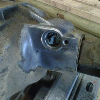tedmc1
Member
- Joined
- January 20, 2017
- Messages
- 38
- Reaction score
- 10
- City, State
- Escondido,California
- Year, Model & Trim Level
- 2002 Explorer XLS
Hi EV1 Just joined the website today and thought I would make my first post. It goes something like this:
The 4.0 SOHC uses a cam chain tensioner on each bank. It's at the front on the drivers side and the rear on the pass side. Without looking back too far in the prev threads I didn't see any mention of these parts (and how they will fail) and how your tensioning cassettes will get wiped out in the process.And if you lose your upper timing chains you will most likely be looking at a new engine.
My 02 4.0 SOHC has 120K miles since new (And I bought it new). Also bought a Premium care warranty along with the car. At 66K lost the transmission due to bad servos+ more and got a new trans for the $100 deductable.My dealership also put new L+R upper cam chain tensioners on my engine at this time since the deductable covered the whole invoice.
I've started noticing the slight noise on cold start and the increased noise level from the cam chain area.
So I pulled them out and as there was very little resistance pressure from either of them, I submerged them in 5W30 and started depressing them. Out came air bubbles and finally a few faint wisps of very dirty oil. After about 15-20 depressings in the submerged oil they finally started to gain resistance pressure until they finally both got pumped up so tightly that I could barely depress them at all. Reinstalled them and chains are quiet again and no extra noise at cold start at all. I have about 350 miles on the car and plan to pull them both out after 1K miles and check them again.
I ordered a new Cloyes tensioner and submerged it and pumped and pumped ......it never got as
strong as the Ford parts with 55K on them. There are quite a few youtube vids on this. Watch them. So rather than spending $120 on a pair of new tensioners why not try to service the old ones first.
Don't have a clue as to why the tensioners ran partially dry as my car has good oil pressure.
The 4.0 SOHC uses a cam chain tensioner on each bank. It's at the front on the drivers side and the rear on the pass side. Without looking back too far in the prev threads I didn't see any mention of these parts (and how they will fail) and how your tensioning cassettes will get wiped out in the process.And if you lose your upper timing chains you will most likely be looking at a new engine.
My 02 4.0 SOHC has 120K miles since new (And I bought it new). Also bought a Premium care warranty along with the car. At 66K lost the transmission due to bad servos+ more and got a new trans for the $100 deductable.My dealership also put new L+R upper cam chain tensioners on my engine at this time since the deductable covered the whole invoice.
I've started noticing the slight noise on cold start and the increased noise level from the cam chain area.
So I pulled them out and as there was very little resistance pressure from either of them, I submerged them in 5W30 and started depressing them. Out came air bubbles and finally a few faint wisps of very dirty oil. After about 15-20 depressings in the submerged oil they finally started to gain resistance pressure until they finally both got pumped up so tightly that I could barely depress them at all. Reinstalled them and chains are quiet again and no extra noise at cold start at all. I have about 350 miles on the car and plan to pull them both out after 1K miles and check them again.
I ordered a new Cloyes tensioner and submerged it and pumped and pumped ......it never got as
strong as the Ford parts with 55K on them. There are quite a few youtube vids on this. Watch them. So rather than spending $120 on a pair of new tensioners why not try to service the old ones first.
Don't have a clue as to why the tensioners ran partially dry as my car has good oil pressure.










